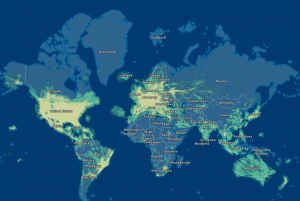FlightAware Announces ADS-B Coverage Growth
FlightAware enters 2018 with unprecedented flight tracking coverage.
Integrating Aireon’s space-based ADS-B with data from our terrestrial stations means we can provide truly global coverage with unprecedented gate-to-gate visibility.”
HOUSTON, TX, USA, January 3, 2018 /EINPresswire.com/ -- FlightAware announced today that it has grown its network of terrestrial ADS-B receivers by 51% in 2017, enabling it to offer surveillance for aircraft flying over land in some of the world’s most remote areas. By adding over 4,000 terrestrial receivers FlightAware is also able to track aircraft movement on the ground at over 200 airports around the world. — Daniel Baker, FlightAware founder and CEO
ADS-B is a surveillance technology via which an aircraft automatically determines its position and broadcasts it, enabling the plane to be tracked. The FAA has mandated that aircraft flying above 10,000 feet in United States airspace must be equipped to send ADS-B positions by January 1, 2020. The requirement also applies to all planes that fly within a certain vicinity of the nation’s busiest airports.
Through its FlightFeeder™ program, FlightAware manufactures and distributes ADS-B receivers to volunteers around the world. The devices track aircraft emitting ADS-B signals for over 250 nautical miles and can also track planes that are not yet ADS-B equipped through a process called multilateration. “It’s an incredible, international effort to crowdsource data,” said Eric Carlson, program manager of FlightAware’s ADS-B network. “We’ve created a community that brings people from over 170 countries together to improve the way planes are tracked.”
The shift to ADS-B tracking is the first major advancement in aircraft surveillance since radar was invented in the 1930s. Terrestrial ADS-B stations improve the quality and accuracy of flight tracking but, like radar, they are limited in their ability to track aircraft over the 70 percent of earth covered by water. To solve this, FlightAware has partnered with Aireon to receive data from Aireon’s ADS-B receivers hosted on the new state-of-the-art Iridium® NEXT satellite constellation. “Integrating Aireon’s space-based ADS-B with data from our terrestrial stations means we can provide truly global coverage with unprecedented gate-to-gate visibility,” said Daniel Baker, founder and CEO of FlightAware.
For more information on FlightAware’s global flight tracking coverage, visit: www.flightaware.com.
About FlightAware
FlightAware is the world's largest flight tracking data company and provides over 10,000 aircraft operators and service companies as well as over 12 million passengers with global flight tracking solutions. FlightAware leverages data from air traffic control systems in over 55 countries, from FlightAware's network of over 13,000 terrestrial ADS-B stations in over 170 countries, Aireon(SM) space-based ADS-B and using global datalink. FlightAware is privately held with offices in Houston, New York and Singapore.
Sara Orsi
FlightAware
713-622-9958
email us here


